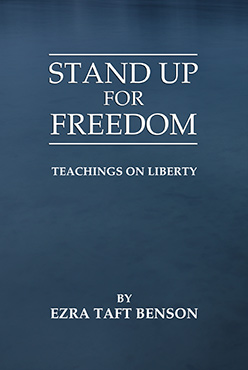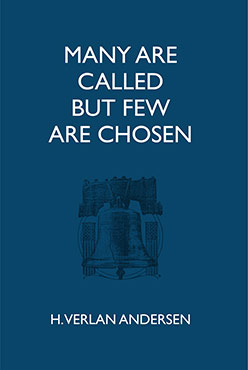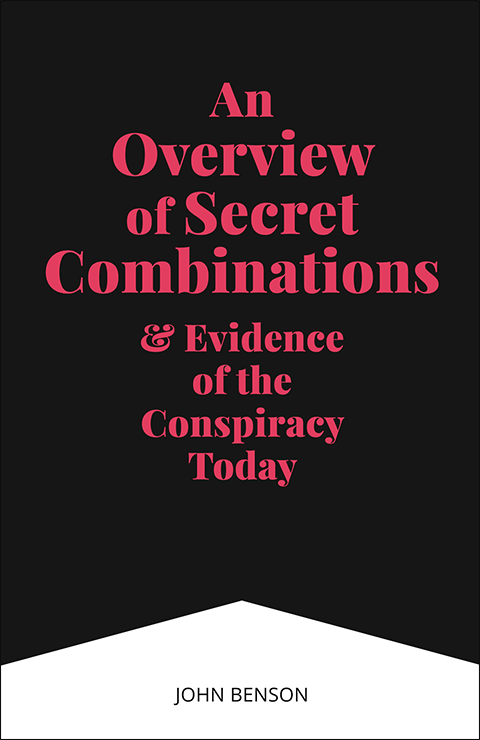What is Left? What is Right?
W. Cleon Skousen. What is Left? What is Right? (1962). Published by the Ensign Publishing Company, 1962.
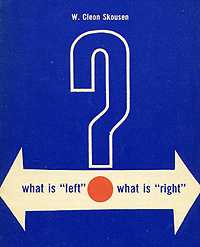
About the author: W. Cleon Skousen was educated in Canada, the United States and Mexico. He received his law degree from George Washington University and was admitted to practice law in the District of Columbia. He served in the FBI 16 years, became a member of the faculty of Brigham Young University in 1951, and was given a leave of absence to become Chief of Police in Salt Lake City in 1956. In 1960 he became the Editorial Director of LAW and Order, the most widely distributed police magazine in the U.S. He is also the author of several books including The Naked Communist and So You Want To Raise a Boy?. In the last two years Mr. Skousen has traveled and lectured in 29 foreign countries and 43 of the 50 states. His largest audience was 15,000 in the Hollywood Bowl.
Political terms like medical terms can be very misleading unless they are carefully defined. Today we hear frequent reference to “those on the right” or “those on the left.” These are common political terms, but what do they mean?
It is surprising how few there are who can accurately distinguish between Communism and Fascism, or Nazism and Socialism. What place does each of these occupy on the world’s political spectrum?
When I was attending college a professor told us that Communism is on the left, Fascism is on the right, and the democracies are somewhere in the middle. I subsequently attended law school and was half-way through a course in Constitutional law when it suddenly dawned on me that the political formula given to my political science class was completely erroneous.
Government is defined in the dictionary as “a system of ruling or controlling” so it seemed that the best way to identify any particular form of government should be in terms of the amount of power or systematic control which that government exercises over its people.
In this connection, it is most important to recognize that labels given to various forms of government are often superficial and misleading. For example, Communists claim their system is a true democracy, which of course it is not, and in Europe today some of the most ardent advocates of socialism are in parties which have claimed to be conservative.
So, in the final analysis it is not the name which is important but the quantity of power or coercive control which a government represents. Let us therefore set up a slide rule to measure the coercive control in each form of government and then fix it in its appropriate place on the world’s political spectrum.
For this purpose we will start with no government or anarchy on the right and total government on the left:
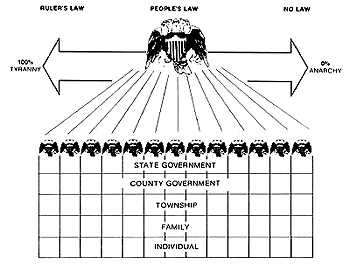
On this slide rule monarchies, dictatorships and other totalitarian governments are all on the extreme left, while anarchy, civil war and lynching mobs are on the extreme right. An “extreme rightist” then is one who tries to operate outside the orderly ranks of government. He is one who tries to take the law into his own hands.
It should be appreciated, therefore, that when a person opposes left-wing movements with speeches, study-groups, and by working through his congressmen, he is operating entirely within the American constitutional framework. If left-wing elements call this kind of person “an extreme rightist” it is a smear tactic.
Monarchy vs. Anarchy
Now let us consider one of the oldest forms of totalitarian government, called a monarchy. This word comes from a Greek term meaning “to rule alone.” Whether Pharaoh, Caesar, Kaiser or King, one-man rule has an odious place in history.
During the development of the European kingdoms, the monarchies adopted the doctrine of “divine right of kings.” This was supposed to give some color of religious sanction to any desperate character who could buy enough mercenaries or rally around him enough desperadoes to seize a throne and hold it. It was contended that such schemes of assassination, conquest or conspiracy would not have succeeded without God’s blessings and therefore the winner must hold his office by “divine right.” The fraudulent nature of such a preposterous doctrine soon became apparent during the Renaissance or Age of Enlightenment. Great forces began to manifest themselves in many countries to overthrow the monarchies or make them the executive branch of the government with merely administrative authority to carry out the laws passed by the people’s parliament or assembly.
In fact, some people decided the whole human race would be better off if there were no governments at all. The anarchists were those who believed men could govern themselves by voluntary association and there was no need for any formal system of government. Thus, Prodhoun in France, Godwin in England, and Kropotkin in Russia all came out for the abolishment of organized government. Many anarchists formed terrorist organizations to disrupt existing governments by any means possible, fair or foul.
Experience soon demonstrated, however, that no government is a chaotic condition which society cannot endure. There is no security, justice or protection of rights at the hands of a mob of vigilantes. So if the extreme left is occupied by the evil power of a self-appointed potentate it is no solution to rush to the extreme right where unorganized mob-rule prevails.
On our slide rule or political spectrum these extremes appear as follows:

Shifting Position on the Political Spectrum
Orderly government, whatever its form, is a delicate and complex device. It is no easy task to shift a monarchy from its position of totalitarian power on the extreme left to a more moderate position nearer the center of the political spectrum. It took England several centuries to achieve it.
But we had an entirely different situation in the French Revolution. The French Revolution was designed to overthrow a profligate monarchy and set up a republic but the revolution got out of control and went all the way to the extreme right; in other words, from monarchy to anarchy, or from total government to a collapse of government. Instead of merely dethroning the king and queen, the revolutionists executed them and then recklessly guillotined 3,000 members of the aristocracy. Then they turned on one another. Before they were through it is estimated that more than 20,000 Frenchmen went to the guillotine or were otherwise executed. By this time the specter of anarchy and disorder was so great that no rights seemed to exist for anybody. Everywhere there was a frantic anxiety to find someone who could restore order. Eventually they thought they had found such a man in one of their brilliant military leaders. His name was Napoleon. The people rallied behind him and the next thing they knew he had made himself emperor and plunged France clear back along the political spectrum to a monolithic dictatorship. He turned out to be as imperialistic and opulent as any monarch they had ever known.
France has been swinging back and forth across the political spectrum in extreme arcs ever since. Even today she is still trying to find that position of security and strength in the delicately balanced center of the political spectrum.
A Lesson From the American Revolution
The American Revolution was also designed to break free from an abusive monarchy but this revolution avoided many of the pitfalls which befell the French. When Friedrich Gentz wrote his famous treatise, “The French and American Revolutions Compared,” he pointed out that the American founding fathers were not revolutionists at heart but statesmen. They wanted peace and spent ten years trying to persuade George III to desist from his unconstitutional abuse of authority. Only when he and his ministers began dissolving the colonial governments and declaring American ships to be the booty of war did the colonists finally assert their right to defend themselves as a separate and free people.
And then, as the first free people in modern times, the American leaders cautiously explored the political spectrum for the best form of government. At first, they settled down too far to the right — too near to anarchy and chaos — by attempting to survive as a nation under a flimsy alliance called the Articles of Confederation. Under this confederation, the Continental Congress was so feeble that it left Washington and the revolutionary army stranded time after time. Washington swore he would work for a stronger central government, once the war was over, and he did.
The U.S. Constitution, therefore, was designed to establish the American eagle right in the center of the political spectrum. With cautious precision, the founding fathers hammered out the framework of the Constitution during the sultry summer months of 1787. It was to be a government of the people with enough power to preserve order and security, but not enough central authority to abuse the people.
To make certain of this, Madison persuaded these political architects to adopt Montesquieu’s unique theory of separation of powers. Thus, the American eagle was given three heads — executive, legislative and judicial — with each one completely sovereign in its own sphere. Therefore, if one gets out of line and begins to usurp authority, the other two are able to combine their strength and pull the obnoxious one back into position. The genius of this plan is to put down an abusive branch of government without requiring the people to resort to force of arms to achieve it.
So here is the position of America’s three-headed eagle on the world political spectrum:
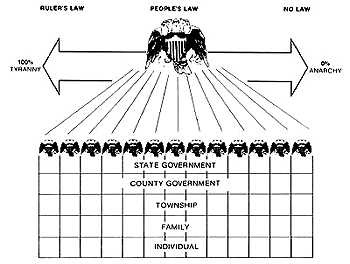
The Two Wings
The American Eagle developed into a two-winged creature. Wing #1 is the progressive wing. Both Democrats and Republicans will be found on this wing. It is the wing which says, “We can do things better! We can do something about education. We can do something about our roads. We can do something about our aged sick. We can do something about our youth.”
Wing #2 also has Democrats and Republicans on it. This is the wing which says: “You folks on #1 have some fine ideas, but we will only go along if you satisfy two conditions: first, can we afford it? Second, can we get it without sacrificing or jeopardizing a significant portion of our freedom?”
It will be seen that Wing #2 is instinctively opposed to a reckless concentration of power in a central government which might violate states rights or wipe out local control of the many phases of life which the Constitution intended to leave with the people. So while wing #1 is dedicated to human improvement and social progress, wing #2 is dedicated to fiscal sanity and the preservation of individual liberty.
Now, as long as these two wings both function, the American eagle is able to fly higher and straighter than any other society in existence. However, if either wing fails to fill its proper function, the eagle starts to swing left or right and loses its precious position in the center of the spectrum.
Recent American history will demonstrate that Wing #1 tends to solve its problems by rushing to the left, trying to seize control of the people, and then using legislative authority to force them to “do what is good for them.” On the other hand, Wing #2 tends to become indifferent to changing times and the need for adjustment and therefore runs the risk of degenerating toward the right and losing the confidence of the people because of the chaos created by unsolved problems.
So this is why it is important to recognize that both wings are essential to the upward flight. Neither wing can say to the other, “We have no need of thee!” Let the progressive wing dream up its marvelous schemes for dynamic progress and then let it patiently hear the demands of the freedom-preserving wing which despises both bankruptcy and slavery as much as it does the lack of progress. If each wing has respect for the other there is no limit to the heights which the American eagle can continue to fly.
An excellent example of how the two wings help each other occurred when Medicare first came up. Wing #1 insisted that something had to be done for elderly people when they became helpless and sick. It was important to recognize this problem. But, having made this essential contribution, Wing #1 could not figure out a way to solve the problem by traditional American methods. It therefore came up with a program called Medicare which had a lot of the earmarks and defects of the left-wing nationalized health services advocated by European socialists.
Wing #2 (which didn’t have the imagination to see the problem originally) did have the imagination to figure out a way to solve the problem in a more traditional American way. Before they were through, the supporters of Wing #2 had come up with a free-enterprise plan which was cheaper than Medicare, covered more people, provided more service, and didn’t involve the Government except as a minor participant.
This demonstrates how the two wings of the Eagle complement each other.
The Extreme Left
Now let us take a look at the proponents of total power which occupy the spectrum on the left. Since the monarchies have become either limited or eliminated, other forces have moved in to advocate total coercive power in government. These have taken the form of several different types of dictatorships.
The first is the International dictatorship. This is the group who believe that Karl Marx was right when he proclaimed that it would be impossible to have universal peace and universal prosperity until the entire earth — with all its human resources and all its natural resources — is forcibly controlled by a single, monolithic, world-wide dictatorship. To achieve this these Marxists advocate the overthrow of all existing societies by revolutionary violence and the establishment of the same type of police state as that which presently exists in the Soviet Union. So this is the program of International Communism. This scheme is the ultimate in political planning to conquer the whole earth. It therefore occupies the most extreme position to the far left:
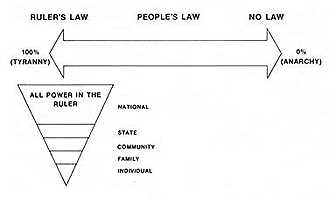
The One-Country Dictatorships
Right next to the Communists is another group of Marxists who believe in the basic ideas of Marxist theory but they don’t think they have to wait for an international dictatorship. They think Marxism can be forced to work under the dictatorship of individual countries. Even Lenin said a lot about “Socialism in one country” after the Communists seized power in Russia, so disciples of Marxism picked up the same theme in other countries. In Germany it became known as National Socialism under the leadership of Adolph Hitler. In Italy it was called Fascism under the leadership of Benito Mussolini.
It often comes as a great shock to some people to hear that the Nazi-Fascist dictatorships are Marxist movements and occupy a position on the political spectrum right next to International Communism. As far as Nazism is concerned, its Marxist framework is the theme of a whole chapter in Frederick Hayek’s book, The Road to Serfdom. On page 169 he says:
“From 1914 onward there arose from the ranks of Marxist socialism one teacher after another who led, not the conservatives and reactionaries, but the hardworking laborer and idealistic youth, into the National Socialist fold. It was only thereafter that the tide of nationalist socialism attained major importance and rapidly grew into the Hitlerian doctrine.”
As for Mussolini, his entire political development was as a left-wing Marxist Socialist. He was a friend of Lenin and only turned away from the theme of international Marxism, when he saw the opportunity to set up a socialist dictatorship in his own country.
Both Hitler and Mussolini quarreled with the Communists, often fought with them, but this must not be misunderstood. They were not quarreling over ultimate ends but over the means. They were resisting the Moscow forces of international leadership. Often they collaborated together as Dr. Stefan T. Possony points out in his book, A Century of Conflict, pp. 198-199:
“It is not without interest to remember that during 1931 and 1932 the German market was flooded with books pleading for German-Russian collaboration and extolling the similarities between the bolshevik and the nazi revolutions. Nazism was indeed described as the German form of bolshevism, and an elusive phenomenon called ‘national bolshevism’ was hailed as the nemesis of senile, tottering capitalism.”
Therefore, on the political spectrum, the one-country Marxist dictatorships properly belong on the extreme left, right next to international Communism.
It is interesting that a Communist will nearly always refer to his enemies as “rightists and Fascists.” Now Fascism is to the right of Communism but only about half an inch! Observe that from the point of view of the American eagle both Communism and Fascism are extreme left-wing.
The Social Democrats
Now there is one other group of Marxists who have proclaimed their devotion to Marx but have insisted that there is no need for revolution and violence. These Marxist socialists believe that if they move slowly and shrewdly they can get people to voluntarily give up their property and their liberties “gradually.” This is their doctrine of gradualism. And it is amazing how well it has worked.
At first, Marx bitterly resisted this soft approach to the seizure of power but in 1872 he admitted that perhaps it might be possible in England and the United States.
Social Democrats have always been embarrassed by the violence and noise of the Communists and often they have resisted them on matters of strategy. However, authorities agree that underneath they have the same common denominator. The close association between Communism and the Social Democrats is emphasized by many authorities on the subject. Dr. Carew Hunt of Oxford makes a typical statement in his book, The Theory and Practice of Communism, pp. 5-6:
“Yet where the ends they seek are concerned, Socialism and Communism are virtually interchangeable terms, as anyone who consults the Oxford English Dictionary or any standard text-book will discover…. Indeed Lenin’s party continued to call itself ‘Social Democratic’ until the 7th Party Congress of March, 1918, when it substituted the term ‘Bolshevik’ as a protest against the non-revolutionary attitude of the socialist parties of the West.”
Dr. Broadus Mitchel spells it out with equal clarity in his chapter on socialism in the book, A Preface to Economics, pp. 556-557:
“Confusion is greatest as to the difference between socialism and communism. The distinction between these two is not one of object, but of means of attainment of the object; it has to do with strategy and procedure, and not with essential theory. Socialism, properly so-called, in its modern phase, looks forward to the setting up of a collectivist society through constitutional means. That is to say, socialism would accomplish the transition from capitalism and private profit to common ownership and production for use, through political channels. The state, the government, is to be captured — gradually, by orderly, parliamentary methods — by the actual producer’s….”
The Communists look upon the Socialists as important allies who run interference for the ultimate Communist touchdown. As the well-known writer, John Strachey, says in his book, The Theory and Practice of Socialism, p. 121:
“We also saw that it is impossible to establish communism as the immediate successor to capitalism. It is, accordingly, proposed to establish socialism as something which we can put in the place of our present decaying capitalism. Hence communists work for the establishment of socialism as a necessary transition stage on the road to communism.”
As we have already mentioned, the Communists are often embarrassed by their Communist bed-fellows so they frequently disavow any sympathy or relationship. It is most easily demonstrated, however, that the Socialists belong on the political spectrum with the rest of the Marxist bloc:
Communists Expect Socialists to Run Interference for Them
In 1960, the 81 Communist parties made it very clear in their latest manifesto that they expected the Social Democrats to serve as their Marxist allies in softening up the free-enterprise democracies and preparing them for a Communist coup:
“Communists regard Social Democrats among the working people as their class brothers. They often work together in trade unions and other organizations, and fight jointly for the interests of the working class and the people as a whole. The vital interests of the working class movement demand that the Communists and Social Democratic Parties take joint action on a national and international scale….” 1
Down through the years, Social Democrats have condoned Communism to an amazing degree. Some Social Democrats have boldly expressed sympathies for the Soviet Union which amounted to open disloyalty toward their own countries,
During World War II, British Socialist G.D.H. Cole stated: “I would much sooner the Soviet Union, even with its present policy unchanged, became dominant over all Europe, including Great Britain, than see an attempt to restore the pre-war States to their futile and uncreative independence and their petty economic nationalism under capitalist domination. Much better be ruled by Stalin than by the restrictive monopolistic cliques which dominate Western civilization.” 2
Similar attitudes among Social Democrats in many parts of Eastern Europe actually facilitated the conquest of those countries by the Soviet Union after the war. 3
Even in the United States pro-Socialist mentalities have had a profound influence on U.S. foreign policy, especially in dealing with the Soviet Union. Many of the most serious miscalculations and diplomatic blunders originated with Marxist-oriented minds who saw the USSR not as an enemy to be overcome but as an ally which must be forced to co-operate in socializing the world.
An American Proponent of Socialism Speaks
A rather shocking example of this type of thinking is found in the words of Dr. Arthur M. Schlesinger, Jr., who presently serves as advisor to the White House and State Department. Mr. Schlesinger often denies that he is a Socialist per se, and even claims that he is definitely anti-Communist, but his writings contain statements such as these:
On Socialism:
“… there is no inherent reason (in the United States) why democratic socialism should not be possible.” 4
“Socialism, then, appears quite practicable within this framework of reference, as a long-term proposition.” 5
“There seems no inherent obstacle to the gradual advance of socialism in the United States through a series of New Deals.” 6
On American Democracy:
“A democracy is politically unreliable at best; the American democracy is notoriously unreliable on all questions of maintaining a continuous foreign policy.” 7
On American Businessmen:
“But the American business community continues to resist radical democracy, like a drowning man threshing out at his rescuer. In so doing, it may destroy the possibility of a peaceful transition to socialism.” 8
On Organized Labor:
“The trade union movement is as clearly indigenous to the capitalist system as the corporation itself, and it has no particular meaning apart from that system. In a Socialist society its functions are radically changed: it becomes, not a free labor movement, but a labor front…. Unions inevitably become organs for disciplining the workers, not for representing them.” 9
On Religion:
“Official liberalism … dispensed with the absurd Christian myths of sin and damnation and believed that what shortcomings man might have were to be redeemed, not by Jesus on the cross, but by the benevolent unfolding of history.
Tolerance, free inquiry and technology, operating in the framework of human perfectibility, would in the end create a heaven on earth, a goal accounted much more sensible and wholesome than a heaven in heaven.” 10
On the Soviet Union:
“… the United States must not succumb to demands for an anti-Soviet crusade nor permit reactionaries in the buffer states to precipitate conflicts in defense of their obsolete prerogatives.” 11 Note that Dr. Schlesinger considers the longing for freedom in the satellites to be merely the dreams of “reactionaries” longing for their “obsolete prerogatives!”
“The United States must maintain a precarious balance between complete readiness to repel Soviet aggression beyond a certain limit and complete determination to demonstrate within this limit no aggressive U.S. intentions toward the USSR. It must commit itself economically, politically, and militarily to the maintenance of this balance over a long period. Given sufficient time, the Soviet internal tempo will slow down.”
On Secret State Department Policy:
“Though the secret has been kept pretty much from the readers of the liberal press, the State Department has been proceeding for some time somewhat along these lines. Both Byrnes and Marshall have perceived the essential need — to be firm without being rancorous, to check Soviet expansion without unlimited commitments to an anti-Soviet crusade, to invoke power to counter power without engaging in senseless intimidation, to encourage the growth of the democratic left. The performance has often fallen below the conception; but the direction has been correct. Men like Ben Cohen, Dean Acheson, Charles Bohlen, have tried to work out details and whip up support for this admittedly risky program. 12
Such thinking was “risky” indeed. Under this program the U.S. and her allies lost 750 million people to Communism in 5 years!
Throughout his writings, Dr. Schlesinger expresses the conviction that the Communist dictatorship will somehow “mellow” and abandon its brutality. They would then become more like genuine Social Democrats (which is the party Lenin supported up to the Russian Revolution of 1917). Dr. Schlesinger then suggests that if the Democracies would give up their “antiquated” concepts of liberty, private property and private planning they could become Social Democrats, too. This is what he means by encouraging “the growth of the democratic left.” All of this is intended to bring the Communists and the Democracies together at the point on the political spectrum presently occupied by the Social Democrats.
Meanwhile, Dr. Schlesinger believes our policy should be to contain Communism but not smother it. In fact, our policy should be to force the Communists to be friends. We should contain them and pamper them all at the same time.
In 1962, precisely the same kind of thinking was submitted to the President in a secret memorandum which was “leaked” to the press by officials who were shocked with its contents. The memorandum was written by Dr. Schlesinger’s friend and colleague, Dr. Walt Rostow, chairman of the Policy Planning Council of the U.S. State Department. A summary of this memorandum is set forth in Congressional Record for July 30, 1962, p. A-5846. The highlights are as follows:
1. Recognize Red China.
2. Compel Chiang Kai-shek to surrender Matsu and Quemoy to Red China.
3. Admit Red China to the U.N.
4. Pull back bases and military forces from the Iron Curtain.
5. Attempt merely to restore status quo if Soviets fire on U.S. or her allies.
6. Refuse to give aid or encouragement to satellites seeking liberation.
7. If Russia refuses to negotiate on arms control and disarmament, then adopt a program which does not require negotiations.
All of this is appeasement and surrender to Soviet Union demands. Dr. Rostow is also one of those who gave pleasure to the Soviet leaders by recommending that the United States disarm and turn over her military weapons to the U.N.
To most Americans this kind of thinking seems completely out of touch with reality.
Left-Wing Mentality Is “Reactionary”
When the American founding fathers set up the first open and free society in modern times they knew they had made the greatest advance in political science since governments were first instituted. It provided the maximum opportunity for people to solve their problems through freedom of choice; and that is all freedom really is: the chance to choose. They instituted the open market to increase the freedom of choice economically. They instituted the open market of ideas with public education, freedom of the press, freedom of religion, and broad participation in government to insure freedom to choose politically and spiritually,
However, Marxist-oriented minds have manifested open contempt for most of these basic principles and have set up reactionary forces to oppose them. They have sought to introduce into the open society its worst enemy — monopoly. They would give to central government the monopoly of power to make most of the choices; to force the people to do what the planners might feel is best for them. They would reduce the opportunity to exercise private initiative, reduce the freedom to compete, the freedom to buy, the freedom to sell, the freedom to produce.
This is all done on the assumption that central planners can calculate the needs of the people better than the people can. Nowhere in the whole world nor in all history has this ever proven to be so. In fact, West Germany demonstrated immediately after World War II that even a country which had been prostrated by war could become one of the richest countries in Europe within ten years by turning the people loose. With even less financial aid than other countries received, West Germany used free-enterprise to develop the greatest period of prosperity she had ever known. Her prosperity became the cornerstone for a United States of Europe movement with a common market economy. By 1959, even the Social Democrats of Germany decided to abandon their traditional claim that prosperity could only be brought about by the nationalization of major industries. Free enterprise had out-produced the socialized industries on every level.
In the face of these facts, it should not seem difficult to chart the course for a future world of peace and prosperity. The basic ideas which allowed Americans (with only 6% of the earth’s population) to produce nearly half of the world’s wealth is not exclusive to any people. Given time and effort these principles can be made to work anywhere. However, in spite of these obvious facts of history, left-wing reactionaries continue to plead for centralized monopoly. They therefore become the brakes on progress, the reactionaries against the expanding freedom of all men. A reactionary mentality inevitably gravitates to the left-wing side of the political spectrum where faith in force prevails over faith in humanity. Even the Social Democrats admit their intention to use force if humanity does not respond to their demands voluntarily. So as we examine the left-wing side of the spectrum we discover that in the struggle for world peace, freedom and prosperity —
Monarchists are reactionary.
Communists are reactionary.
Nazis are reactionary.
Fascists are reactionary.
Socialists are reactionary.
Conclusion
It is entirely understandable why reactionary minds would use cybernetic bullets or smear tactics to prevent the public from discovering what is going on.
In our time, nothing has panicked the extreme left-wing forces as much as the Freedom Forums, seminars, home study groups and courses on Communism in the schools. These public education programs rallied so much support that they began to have unexpected impact on the United States Congress.
The liberals, “fronters” and Communist Party members immediately made violent protest shouting “Fascists! Rightists! Extremists!” For awhile this caused some confusion, but today more people are becoming informed. More Americans are beginning to see the basic issues involved and are anxious to hear authorities who know the problems and have developed some constructive answers.
Those who try to keep traditional, standard-brand Americans from finding out the truth will have increasing difficulty. Americans don’t stay muzzled very long. They are beginning to find out what is on the left and what is on the right. They are also beginning to realize that the happy and abundant way of life which Americans have enjoyed for so many years is in serious jeopardy.

